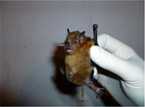"Have You Heard?"
Archive: 2011 | 2010 | 2009 | 2008
Bat Flu

A new and dramatically different influenza A virus has been discovered in fruit bats. The findings by scientists from the Centers for Disease Control and Prevention working with the Universidad del Valle of Guatemala are described in an article published in the Proceedings of the National Academy of Sciences (PNAS) journal March issue.
This is the first time an influenza virus has been identified in bats, but in its current form the virus is not a human health issue, according to the study’s scientists. Preliminary research at CDC on the new virus suggests that its genes are compatible with human influenza viruses. As a result, it is possible that these bat viruses could eventually gain the ability to cause infections in humans. However, CDC experts have been unable to grow the bat influenza virus in test tubes, suggesting that the virus is currently not well suited to causing human illness. For the bat influenza virus to infect humans, it would need to obtain some genetic properties of human influenza viruses. This can occur in nature through a process called “reassortment.” Reassortment occurs when two or more influenza viruses infect a single host cell, which allows the viruses to swap genetic information. Reassortment events can sometimes lead to the emergence of new influenza viruses.
CDC’s Global Disease Detection Program (GDD) established a regional center in Guatemala and has worked there since 2007 to rapidly respond to emerging infectious disease threats. Bats were targeted for investigation by GDD because they are hosts for many emerging infectious diseases. With the assistance of the GDD Guatemala Regional Center and the University of the Valley’s field team, CDC’s Rabies Program took the lead in swabbing the bats. A total of 316 bats from 21 different species were captured and tested from eight locations in southern Guatemala during 2009 and 2010. (Videos showing how specimens are collected from bats in Guatemala are available here and here.) The extent to which influenza viruses are circulating in bat populations remains unknown. Additional studies are being conducted to better understand how common influenza viruses are in bats from Central American and other regions. This species of bats is not native to the continental United States.
“These collaborations are fantastic opportunities to contribute to scientific development but also to strengthen capacities in countries like Guatemala where populations strive daily with basic needs,” said Celia Cordón de Rosales, director of the Universidad del Valle’s Center for Health Studies.”
CDC and disease experts around the world monitor influenza viruses that circulate in animals because the previous pandemics of the 20th century as well as the 2009 H1N1 pandemic were caused by influenza viruses in animals that gained the ability to infect and spread easily in humans.
The journal article is available online here. For more information about CDC’s global disease detection and emergency response activities, please see www.cdc.gov/globalhealth/gdder/gdd/. Influenza related information, including influenza in animals, is available at www.cdc.gov/flu. For more information on bat influenza and how it is different from other influenza viruses, please see Bat Influenza Questions and Answers.
- Historical Document: 2011
- Content source: Office of the Associate Director for Communication
- Notice: Links to non-governmental sites do not necessarily represent the views of the CDC.
View Press Releases in
Contact Us:
- Centers for Disease Control and Prevention
1600 Clifton Rd
Atlanta, GA 30333 - 800-CDC-INFO
(800-232-4636)
TTY: (888) 232-6348 - Contact CDC-INFO

